
Shortfin mako shark – Isurus oxyrinchus – Photo courtesy of NOAA-PIRO Observer Program.
Longfin Mako Shark
The Longfin Mako Shark is a rare species, found mainly in tropical and temperate waters. although not confirmed, they are thought to be distributed worldwide. It is larger than the Shortfin Mako, reaching at least 2.5 metres in length and weighing over 70 kilograms.
The shark is long and the front and back of its body are both tapered. The Longfin Mako is characterised by long gill slits that extend onto the top of its head, as well as long first dorsal fins and small second dorsal and anal fins. The tail fin, or caudal fin, has a crescent shape.
The Longfin Mako Shark has large serrated teeth, designed to grab and hold its optimal prey of squid and small bony fish. The outer row of teeth in the lower jaw protrudes noticeably.
The Longfin Mako Shark is pelagic, meaning that it stays in the deep, cool waters of the open ocean rather than approaching the shallow banks of the coastal areas.
They are ovoviviparous. Eggs are fertilised inside the oviduct of the female, where they hatch. Hatchlings are then further sustained within the oviduct until they are fully developed, with sharp teeth and hunting instincts. Once they are born alive into the ocean, they immediately live an independent life. The first pup to hatch usually eats unviable eggs within the mother’s body. This cannibalism is called oophagy. Usually, only two pups are born.
The Longfin Mako is not known for attacking humans. Its greatest threat is fishermen, who catch it by accident (in fishing nets), or for its fins, skin or jaws. Its meat can be used for animal feed, but it not generally consumed by people.
The Shortfin Mako Shark
The Shortfin Mako Shark is certainly the better known of these two species. It is characterised by its elongated body, long snout, bluish-black dorsal side and white belly. These sharks reach lengths of between 1.8 and 3.2 metres, with females being significantly larger than males. Females also live longer than their male counterparts. Their hydrodynamic shape makes it possible for these animals to reach impressive speeds of around 50 kilometres an hour, and to leap out of the water in pursuit of prey. In fact, there have been reports of Shortfin Makos jumping right onto the boats of fishermen.
The long, thin, smooth-edged teeth are visible even when the Shortfin closes its mouth. Evidence shows that they prefer eating bluefish, but will also dine on other bony fish, sharks, dolphins, porpoises, turtles and seabirds.
The Shortfin Mako Shark enjoys temperate and tropical waters and is usually found within the top 150 metres of the ocean. It does not usually approach the coastline, but has been spotted closer to land than usual when in the vicinity of an inlet or island. They migrate far distances from their local habitat in search of food.
The Shortfin Mako is ovoviviparous. Eggs are fertilised within the mother’s oviduct by a male. They hatch in this oviduct, and the hatchlings continue to live inside her for a period, eventually being born alive into the ocean when they are fully developed. The strongest or first hatchling is known to eat its siblings;a process called oophagy.
The Shortfin Mako Shark has been recorded for its unprovoked attacks on human beings as well as its aggressive nature with boats in the water.
For more information, please view: https://www.nmfs.noaa.gov